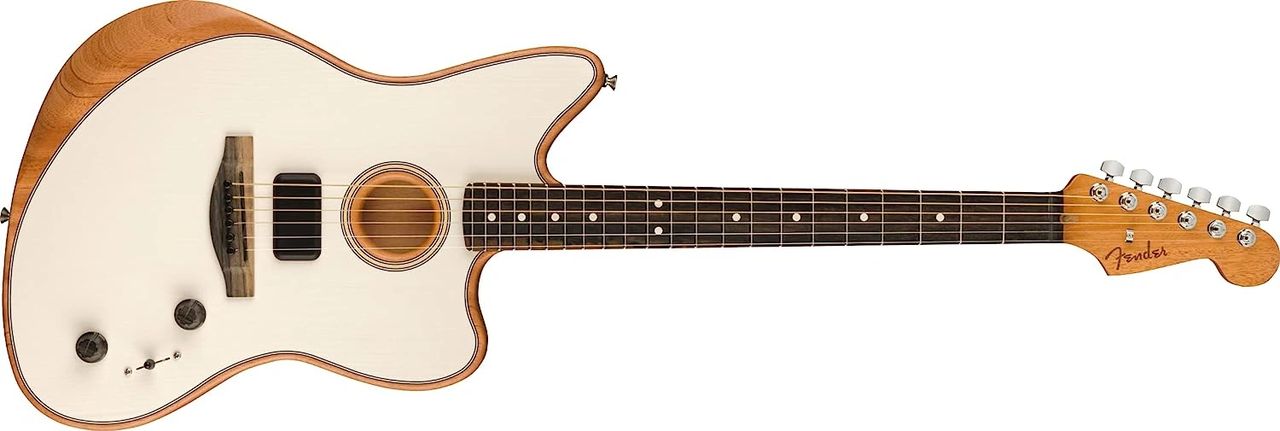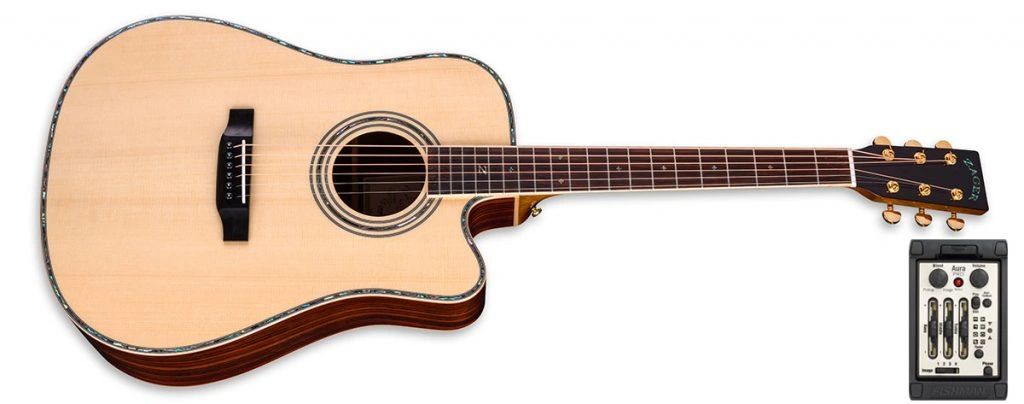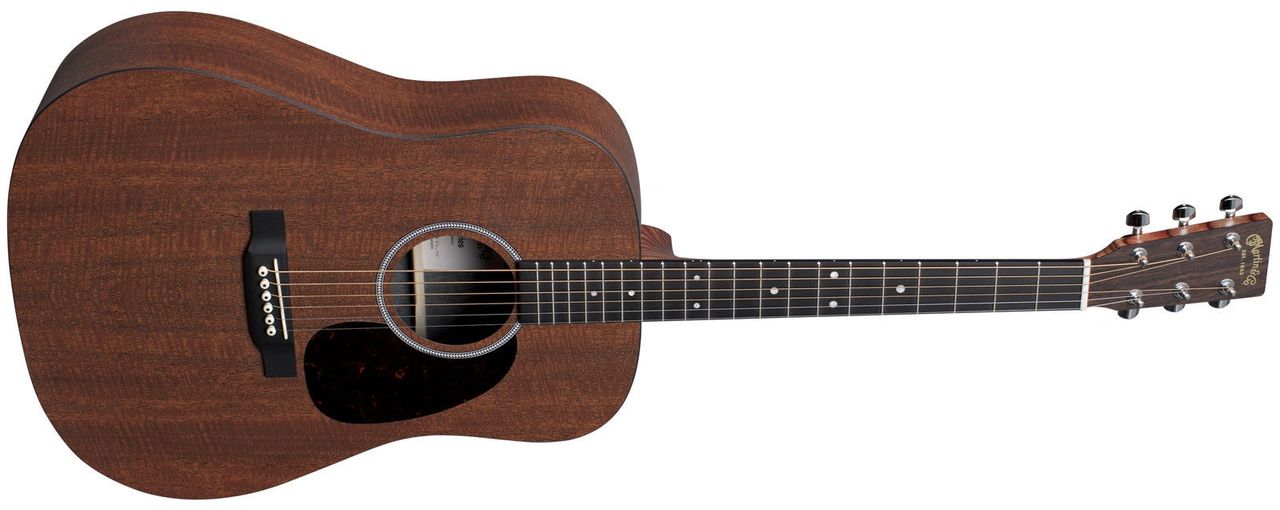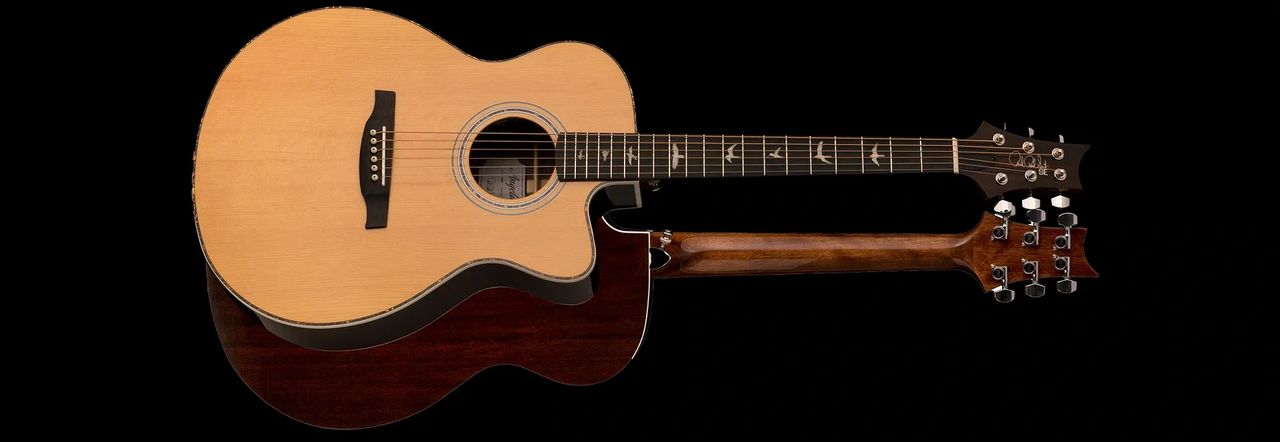
Budding guitarists ready to make the transition from a beginner to an intermediate acoustic-electric guitar need an instrument that scales with your experience. You may have selected a beginner’s guitar that holds up to some serious practice, but a cheap instrument with subpar tonewoods will impact long-term playability and sound.
Instead, an intermediate guitar blends quality and sound and can transition on or off the stage. If you’re not sure where to start, here’s a look at how to select the best intermediate acoustic-electric guitar for you to take your skills to new levels.
Why Buy an Acoustic-Electric Guitar?
An acoustic-electric guitar looks like a standard acoustic model but comes with built-in electronics, just like an electric guitar. It can also save you both time—all you need to do is plug in your instrument to an active speaker, and you can start gigging. An acoustic-electric guitar can also give you some flexibility to play around with your signature sound, including reverb or modulation.
Define Your Musical Style
Before exploring the world of intermediate acoustic-electric guitars, you need to figure out how to define your musical style. From rock to blues, different guitars excel in specific categories. Playing with a band can also impact the type of intermediate acoustic or electric guitar you choose to buy.
Body Style
The body style of your acoustic-electric guitar will significantly impact how it sounds and how comfortable it is to play. Here are a few of the options to choose from:
- Dreadnought: The most popular body type, with a big, powerful sound and versatility for many styles of music
- Grand Concert: One of the three most common types of acoustic guitars
- Grand Auditorium Cutaway: One of the three most common types of acoustic guitars
- Travel or Small Body: Often half- or 3/4-sized, travel guitars are highly portable and easier to play
- Slope-Shoulder and Round-Shoulder: Similar to dreadnoughts, a sloped or round-shouldered guitar has more of a gradual curve from the body to the neck
- Orchestra: Smaller than a dreadnought, an orchestra guitar is considered a mid-size guitar with reliable balance, volume, and projection
- Parlor: A compact and narrow-waisted instrument that usually has less than 12 frets
- Classical Guitar: Unlike the steel strings fitted on most acoustic guitars, classical guitars have nylon strings for a mellow sound
Musicians with larger statures usually gravitate towards a bigger guitar, such as a Grand Auditorium, but a smaller player may be more comfortable with a parlor guitar. There’s no rule that your body size should dictate the size of guitar you select, but it can impact how comfortable it is to play.
Tonewoods
Tonewoods play an integral part in how your acoustic-electric guitar will sound, especially when plugged in and played to a crowd. Here’s what to expect from different tonewoods with your next intermediate acoustic-electric guitar selection:
- Mahogany: Warm and full with more mid-range emphasis
- Rosewood: Sounds bright and rich, with more treble and bass emphasis
- Cherry: Emphasizes middle and treble tones but doesn’t always hold up well to bass frequencies
- Indian Rosewood: Delivers clear sound, even with a deep bass frequency
- Spruce: Produces a warm tone that doesn’t sound too thin
- Sitka: Well-rounded, robust sound with a dynamic response
- Cedar: A warm wood that tends to be quieter and not as bright as other tonewoods like Sitka
- Honduras Rosewood: Enjoys unparalleled sound qualities and is known for its hardness and durability
- Heavy, Dense Woods: Tends to produce a fuller, richer sound
- Light woods: Creates a thinner, brighter sound
Some guitar manufacturers use a blend of tonewoods and synthetics to get the right sound. For example, a brand like Ovation is often polarizing in the guitar community for its use of plastic and similar materials. Although the sound is different from using tonewoods, using the same synthetic materials makes it possible to get a more consistent sound.
If sound is an important factor to you, get the Guide to Choosing the Best-Sounding Acoustic Guitars.
Neck Profile and Playability
The neck profile and playability of an acoustic-electric guitar will influence how comfortable it is to play. It’s an important factor if you want to practice for hours or make guitar your full-time hobby or job.
Some of the most common guitar necks are shaped like a C, which is sometimes referred to as an oval-shaped neck. However, they don’t always scale well if you have large hands. Some guitar brands also have their own unique neck profile, like Zager Guitars, which hand makes their instruments and focuses on comfort and playability, no matter your hand size.
If you’re not sure where to start, get the guide on What to Look for in a Guitar Neck Shape.
Build Quality and Brand Reputation
Quality and brand recognition go hand in hand, but quality is a consideration when picking an intermediate acoustic-electric guitar. Yes, it’s okay to pick an intermediate acoustic-electric guitar from a lesser-known brand, but you don’t have any context for their track record of success. At the same time, a renowned guitar brand can also come with quality issues, especially if it’s manufactured overseas at a cheaper price point.
Ideally, you want a guitar that has enough brand recognition to show that the company has paid its dues in the market and earned a measure of success. But you shouldn’t pick an intermediate acoustic-electric guitar based on the brand name alone. You could end up buying a very expensive guitar with premium brand recognition that only sounds and plays “okay.”
Budget
There’s no need to spend $5,000 on an intermediate acoustic-electric guitar, but to find something that sounds great, you need to spend at least $500. There are always exceptions, and it also depends on your personal preferences. If you want this to be the last guitar you ever buy, then spend as much as you can for the best quality. But for most players, intermediate should come with an in-between sweet spot to find a well-constructed guitar with a quality electronics package at a reasonable price point.
Know the Types of Acoustic and Electric Guitar Pickups
Capturing acoustic sound can be done in different ways that all come with their share of pros and cons. But at the end of the day, they all do the same thing: Project your acoustics and create a louder sound. There are three main groups of electronics used to “pick up” sound, each with their own pros and cons. Essentially, they all do the same job:
- Piezo: The piezo is usually located between the bridge saddle and bridge and detects vibrations from the strings. The voltage is altered by the special piezoelectric material when it’s fed through the cable into your preamp for a clear, direct sound.
- Magnetic Soundhole: A magnetic soundhole helps distribute the vibrations of your acoustic-electric guitar. These magnetic systems produce a clear sound similar to that of an electric guitar and are more or less the same as an electric guitar pickup.
- Microphone: Acoustic-electric guitars use a mini microphone inside the guitar to create a bigger sound, but it can produce feedback.
The electric package is a primary reason why you need an intermediate acoustic-electric guitar. An inexpensive beginner guitar often comes with cheap tonewoods and subpar electronics. The result is an instrument with a sound that can’t scale with your ambition.
Best Intermediate Acoustic and Electric Guitars
Now that you know what to look for in an intermediate acoustic-electric guitar, it’s time to select the best instrument for you. Here are some options to help you get started on your journey.
Best for Budget: Epiphone Hummingbird Pro

The Epiphone Hummingbird PRO is based on the popular Gibson Hummingbird model and is part of the Gibson umbrella. With a solid spruce top and mahogany back and sides, this intermediate acoustic-electric guitar is a good choice for its affordability and sound quality. But it’s not as high-quality as a Gibson and doesn’t come with a cutaway that some musicians find more comfortable and aesthetically pleasing.
The Epiphone Hummingbird Pro retails for $499.
Best for Brand Recognition: American Acousticonic Jazzmaster

This lightweight guitar is comfortable to play with a natural feel and is ideal for strumming and songwriting practice. It’s also a good choice if you’re planning to play out or travel and want something easy to carry around. But if you just want a lightweight, portable guitar, you can find something cheaper in a parlor guitar or travel guitar option. Overall, the Acoustasonic is versatile, with quality pickups and a good sound.
The American Acousticonic Jazzmaster retails for $1,999.
Best Overall Acoustic-Electric Guitar: Zager ZAD900CE Full Size Acoustic-Electric

The Zager ZAD900CE features a Fishman AURA Sound Imaging system with a built-in auto tuner. With solid Sitka, Spruce, and Indian Rosewood tonewoods, it features a curly maple binding and pearl inlay. Zager also prioritizes quality by handcrafting every item and using pillow-touch, carbon-coated strings that make them easier to play.
Some musicians don’t like that you can’t try out a Zager Guitar in the store, as they sell directly to the consumer to keep your costs down. But they do offer free, two-way shipping and a generous return policy, making them an easy choice for your intermediate guitar collection.
The Zager ZAD900CE retails for $2,395.
More Intermediate Acoustic and Electric Guitar Options
Still not sure what to pick? Here are some other acoustic-electric guitars on the market to choose from.
Martin D-X1E Acoustic-Electric Guitar

The Martin D-X1E Acoustic-Electric Guitar is a dreadnought-size guitar with a cutaway body and spruce top to produce a warm and mellow tone. Its Scalloped X bracing is designed for improved projection and sound. With a high-pressure laminate top, back, and sides, this guitar holds a great sound that projects, despite its lack of high-end tonewoods.
The Martin D-X1E retails for $549.
Ovation CE44 Celebrity Elite Plus Acoustic-Electric Guitar

This six-string guitar comes equipped with a multi-soundhole design, providing clear highs and a balanced bass. Unlike other guitars, the Ovation was designed for acoustic guitarists who want to amplify their sound on stage. Headed up by a team of engineers, they determined the perfect size, shape, and materials to produce a consistent sound. But Ovation is a polarizing brand: If you’re into the classic sound of tonewoods and the craftsmanship of an acoustic, this isn’t the right pick for you.
The Ovation CE44 Celebrity Elite Plus Acoustic-Electric Guitar retails for $564.
Taylor American Dream AD17e

The Taylor American Dream AD17e comes in a matte black Sitka spruce top with a back and sides made from Ovangkol wood and a fantastic warm, shimmering midrange. With V-class bracing and solid wood construction, it’s a great choice for strumming and fingerpicking with dynamic volume.
This guitar is outfitted with Taylor’s Expression System 2 (SE2) with a 3-sensor pickup. The master volume control and tone controls allow you to tweak the output from the stage, while a phase switch suppresses potential feedback.
The Taylor American Dream AD17e retails for $1,949.
PRS Angelus SE A40E Acoustic Guitar

PRS Angelus SE A40E Acoustic Guitar features six strings with a solid spruce top and ovangkol back and sides. With a comfortable body shape, it produces a smooth, versatile tone and plays comfortably for open and barre chords. Some players dislike the wider, fatter neck, especially if they have smaller hands or want a more comfortable guitar.
The PRS Angelus SE A40E Acoustic Guitar retails for $639.
Final Thoughts
Choosing the right intermediate acoustic-electric guitar is a big milestone in taking the next step in your musical journey. Whichever guitar you pick, make sure it balances the quality, playability, and budget you’re looking for while honing your skills. Still not sure what to choose? Get the guide: The 10 Best Acoustic Guitars in 2023 (and What to Look For).
